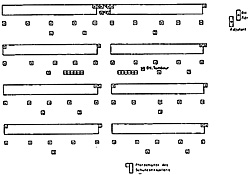Wheeling with a moving pivot and forming
One of the advantages in having the pivot move was that the manoeuvring sub-unit vacated the pivot point as quickly as possible, so that the following rank or sub-unit could occupy it. This avoided queuing. A disadvantage was that a moving pivot marched on an arc and a right-angled turn on the spot was no longer possible. Forming, however, allowed such a turn whilst, at the same time, removed the pivot from the pivot point and was altogether a more flexible means of changing direction through 90 degrees.
Forming, although frequently referred to as wheeling with a moving pivot is not, strictly speaking, wheeling at all insofar as the rank does not come round as one. In simple terms this manoeuvre required the pivot to execute a turn towards the required direction and march onto the new alignment. The remainder of the sub-unit marched in files and fell in on the new alignment, dressing on the pivot. This manoeuvre can be seen being performed at the Trooping the Colour ceremony in London, when the 90 degree turn is made before passing in front of the saluting base.
The importance of the sub-unit and the command element
Although wheeling was a means by which a column or line changed direction or front, either on the march or at the halt, the ability to wheel in one form or another was a fundamental skill which was vital to a significant number of essential conversions. Wheeling, like all manoeuvres, was conducted by individual sub-units and it was the movements of these component parts of the battalion that were choreographed into conversions.
There is, however, an impression that a battalion was a unitary body that moved as one. Nothing could be further from the truth. It moved by its component parts and to help illustrate what this entailed, detailed diagrams showing French and Prussian companies deployed in line are at Illustrations 5 (top) and 6 (middle), [10] and the Prussian angriffs-colonne at illustration 7 (bottom). [11]
Prussian Musketeer Kompanie in Line (1812-1815) in three ranks
1 Unteroffizier im Gleid + 83 Musketiere in 28 Rotten je Section (Zug)

French Fusilier Kompanie (6 Kompanieren im Batallion) (1808-1815)
Six Korporal im Gleid + 144 Fusiliere in 50 Rotten

Prussian Angriffs Colonne (Attack Column) (1812-1815)

There are two things to note here. The first is that soldiers always stood in line in their respective sub-units, regardless of the formation adopted by their unit. The second is that both the sub-unit and unit were complex structures. To persevere, imagine taking a number of sub-units and have them conduct any conversion together whilst maintaining cadence, length of pace, lateral dressing and intervals between each other, without falling into confusion, and I hope that it gives a better idea of what was involved when we come to look at examples of changes of direction and position at unit level.
Before doing so, it will be seen that even in these close formations there was a space between each sub unit in which stood the supernumeraries, the officer and NCO cadre, who were responsible for conducting the sub units through the various movements. The competence of this command element at sub-unit level was even more important than the individual skills of the soldiers in the ranks, for it was the former who told the latter what to do. It is also clear that in order to maintain a semblance of unit integrity as a whole, it was absolutely vital that dressing between individuals and sub-units be maintained. The effect of combat upon all these component parts, of course, was to degrade that integrity but the better trained, commanded and controlled the unit was, the longer and better it was able to move and fight.
Wheel Continued
-
Introduction
Life Before Cadence
Wheeling With a Stationary Pivot
Wheeling With a Moving Pivot
The Regulations: France
The Regulations: Prussia
The Regulations: Austria
The Regulations: Britain and KGL
Summary and Conclusions
Footnotes
This article appears in MagWeb (Magazine Web) on the Internet World Wide Web.
[10] Schwarz, Herbert. Gefechtsformen der Infanterie in Europa durch 800 Jahre. München, 1977. Vol II Illustrations 124 and 115.
[11] Ibid. Illustration 125.
Back to Table of Contents -- First Empire #28
© Copyright 1996 by First Empire.
Other military history articles and gaming articles are available at http://www.magweb.com